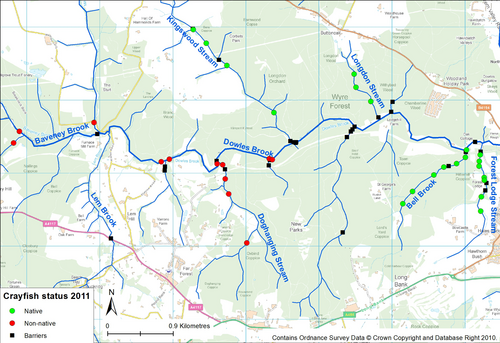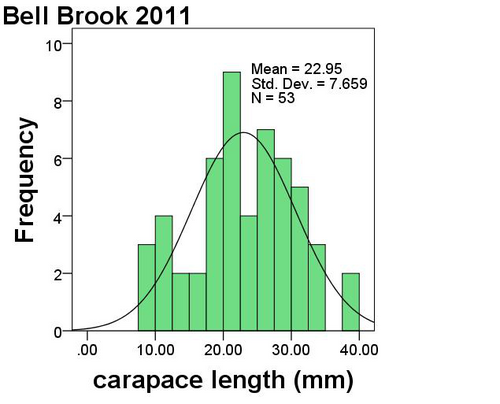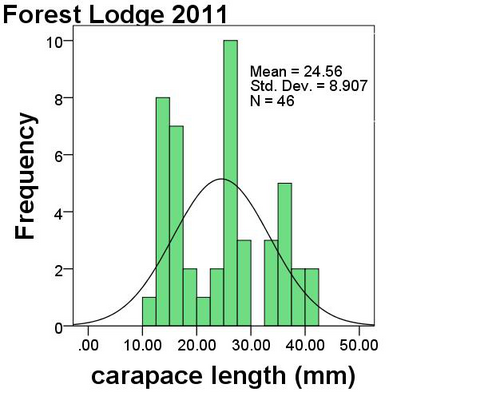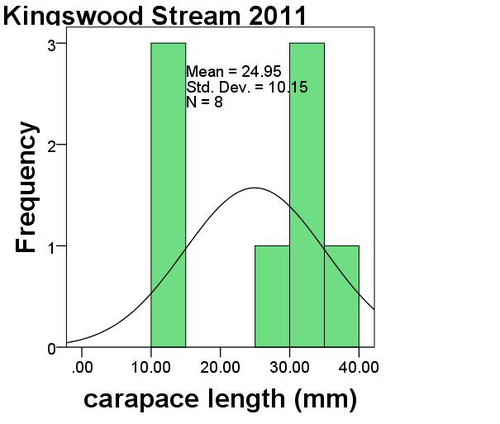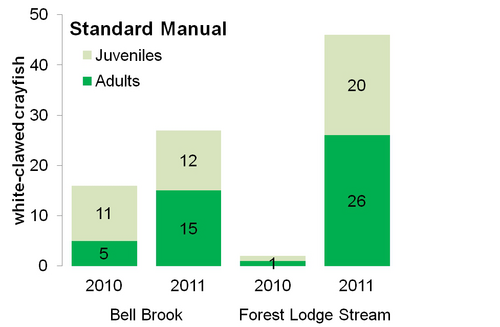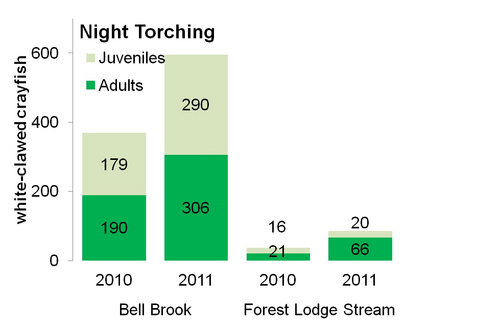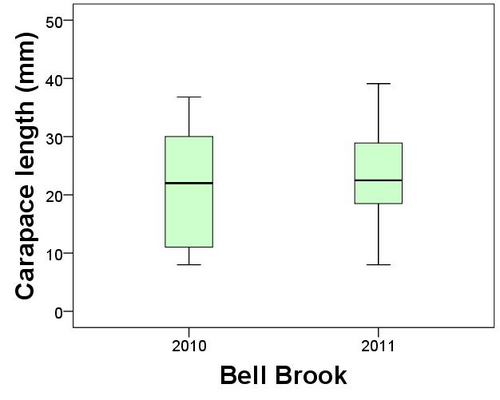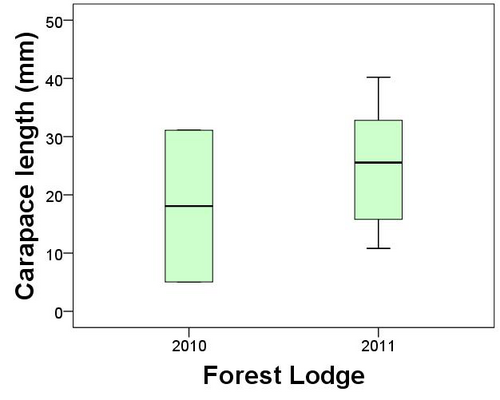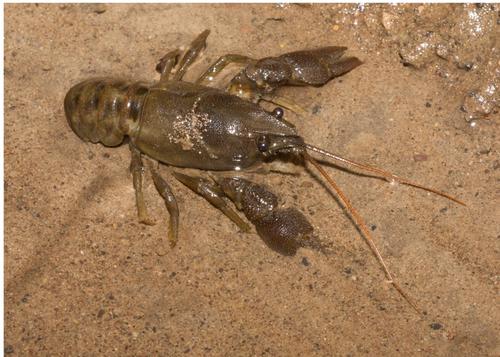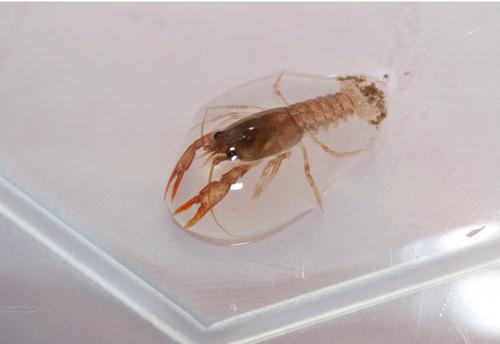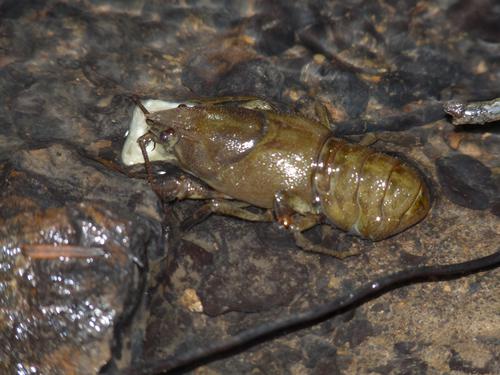Crayfish of Wyre Forest – an update
Ann Hill
Introduction
In 2010 a baseline study of the native white-clawed crayfish in two tributaries of Dowles Brook, Wyre Forest was undertaken (Hill 2010a & b). In 2011 the baseline study was repeated and expanded to include a study of the distribution of the species in Dowles Brook and all its associated tributaries that flow within the Wyre Forest.
Methods
The 2011 survey work was undertaken between 3rd August and 4th October following published guidelines and best practice (Peay 2002). A qualitative appraisal of likely white-clawed crayfish habitat (and preliminary daytime safety check) was undertaken of all forty-three waterbodies within the stream network of the Wyre Forest. Night-time torching (using a 15-minute timed search) was undertaken of twenty waterbodies that the habitat appraisal found to have the suitable combination of habitat and flow conditions to support crayfish. A standard daytime manual search was made of all those waterbodies where evidence of white-clawed crayfish was found during the night-time torching survey. A standard daytime manual search was also undertaken of five waterbodies where doubt remained as to the presence of white-clawed crayfish. Baited traps replaced a daytime manual search in those waterbodies where the water was >0.5 m deep. Additionally, the 2010 baseline survey of Bell Brook and Forest Lodge Stream was repeated using the same team of surveyors, the same number and location of sample stretches and the same amount of survey effort.
A total of twenty night-time torching surveys (fifty-six 15-minute timed searches); six trapping sessions (105 baited traps); and ten manual standard surveys (370 refugia searched) were undertaken. The study sampled twenty-three percent of the available channel length (17.2 km from a total channel length of 74.6 km). It was not possible to sample the entire length of every watercourse but by using the recognised survey protocol it was ensured that a representative sample was undertaken. No constraints regarding climatic conditions were identified during the survey and there were no periods of increasing or high river flow.
Results
The 2011 survey effort produced a total of 850 white-clawed crayfish records and 119 American signal crayfish records. Please note that the aim of the study was to map the distribution of white-clawed crayfish and therefore, less survey effort was spent on surveying watercourses found to have non-native crayfish populations and hence lower numbers of non-native crayfish are to be expected. A summary of the records from all the surveys is given in Table 1.
Table 1: Crayfish recorded within Dowles Brook and associated tributaries, Wyre Forest, Worcestershire/Shropshire during August to October 2011 using different survey methods.
Watercourse | Date | Method | Records | |
| Native Crayfish | Signal Crayfish | |||
| Baveney Brook | 16/08/2011 | Torching | 0 | 6 |
Bell Brook | 12/08/2011 | Casual | 17 | 0 |
| 15/08/2011 | Casual | 37 | 0 | |
| 24/08/2011 | Standard | 27 | 0 | |
| 19/09/2011 | Torching | 4 | 0 | |
| 31/08/2011 | Torching | 588 | 0 | |
| Bell Brook Pool | 31/08/2011 | Torching | 4 | 0 |
Doghanging Stream | 15/09/2011 | Standard | 0 | 9 |
| 03/08/2011 | Torching | 0 | 93 | |
Dowles Brook | 20/08/2011 | Torching | 0 | 2 |
| 15/09/2011 | Casual | 0 | 1 | |
| 02-03/09/11 | Trap | 0 | 3 | |
| 03-04/09/11 | Trap | 0 | 1 | |
Forest Lodge Stream | 24/08/2011 | Rescue | 46 | 0 |
| 25/08/2011 | Torching | 59 | 0 | |
| 01/09/2011 | Torching | 27 | 0 | |
Kingswood Stream | 27/08/2011 | Standard | 13 | 0 |
| 23/08/2011 | Torching | 19 | 0 | |
| Lodge Coppice Stream | 17/08/2011 | Torching | 0 | 2 |
Longdon Stream | 30/08/2011 | Standard | 1 | 0 |
| 30/08/2011 | Torching | 8 | 0 | |
| Mad Brook | 22/08/2011 | Torching | 0 | 2 |
White-clawed crayfish were recorded in four watercourses: Bell Brook (including Bell Brook Pool), Forest Lodge Stream, Kingswood Stream and Longdon Stream, within the downstream tributaries of Dowles Brook, in the east of the Wyre Forest study area, (Fig. 1).
American signal crayfish were detected in five watercourses: Baveney Brook, Doghanging Stream, Dowles Brook, Lodge Coppice Stream and Mad Brook, within the west of the Wyre Forest. Above Furnace Mill, the upstream limit of detection of American signal crayfish was at the confluence of Lodge Coppice Stream and Baveney Brook. The downstream limit of detection of American signal crayfish was where the forestry road crosses Dowles Brook, near to the Mercian Way signpost. Suitable crayfish habitat was present but crayfish were absent or undetected in ten waterbodies: Doghanging Tributary 2, Dowles Tributary 1, Far Forest Stream, Gladder Brook, Lem Brook, Neenshill Stream, Park Brook, River Rea, Tibbet's Stream and Withybed Stream.
The relative abundance of crayfish in an individual watercourse was calculated as the number of crayfish caught per ten refugia searched (Catch per Unit Effort, CPUE) and were compared with CPUE categories determined from standard surveys undertaken nationally (Peay 2002).
Bell Brook: A CPUE of 5.4 which equates to a very high population of white-clawed crayfish (i.e. very high >5 CPUE, Peay 2002).
Kingswood Stream: A CPUE of 2.17 which equates to a moderate population of white-clawed crayfish (i.e. moderate >=1, <3 CPUE, Peay 2002).
Longdon Stream: A CPUE of 0.14 which equates to a low population of white-clawed crayfish (i.e. low >0, <1 CPUE, Peay 2002).
No comparison could be made with the numbers of white-clawed crayfish in Forest Lodge Stream because the standard manual day-time survey became a rescue operation to move stranded white-clawed crayfish (and fish) to pools within the same tributary. However, it was likely from the numbers recued in the day-time survey (46 individuals) that the stream would be classed as having a high population (i.e. >=3, <=5 CPUE, Peay 2002) of white-clawed crayfish.
The white-clawed crayfish carapace length (CL) of individuals caught and measured ranged between 8.0 mm and 39.1 mm in Bell Brook, 10.8 mm and 40.2 mm in Forest Lodge Stream and between 12 mm and 35 mm in Kingswood Stream. A juvenile is taken as size <25 mm CL. There were too few observations (<30 observations) to comment on population status in Kingswood Stream and no white-clawed crayfish were measured in Longdon Stream (all escapees). However, analysis of the carapace size distribution (Figs. 2.) indicates that there was a:
Stable population of white-clawed crayfish in Bell Brook (skewness -0.074).
Recruiting population of white-clawed crayfish in Forest Lodge Stream (skewness +0.212).
Figs. 2a, 2b, 2c: Histograms showing size distribution (carapace length) of white-clawed crayfish population in three tributaries of Dowles Brook, Wyre Forest, Worcestershire/Shropshire.
Monitoring Study
There was a non-significant increase in the number of observations of white-clawed crayfish in Bell Brook in 2011 compared with observation made in 2010 (Kruskal-Wallis test, sig. = 0.609, p = n.s., n = 32), (Figs. 3.).
There was a statistically significant increase in white-clawed crayfish observations from the night-time torching in Forest Lodge Stream in 2011 compared with observation made in 2010 (Kruskal-Wallis test, sig. = 0.034, p = 0.05., n = 16). However, the increase in observations may be as a result of low water conditions concentrating the population into a smaller area. Absence of water and low flow conditions prevented replication of the 2010 daytime standard survey in Forest Lodge Stream in 2011. Instead stranded dying crayfish (and fish) were rescued and transferred to small in-stream pools.
Fig. 3a & 3b: Comparison of white-clawed crayfish records observed in Bell Brook and Forest Lodge Tributary, Wyre Forest in 2010 and 2011 using standard manual method and night torching.
The relative abundance of crayfish (CPUE) increased from “high” population abundance in 2010 to “very high” population abundance of white-clawed crayfish in Bell Brook in 2011, Table 2. The relative abundance of white-clawed crayfish in Forest Lodge Stream was “low” population in 2010 and as discussed previously in this article, the population abundance would now be classed as a “high”.
Table 2: Comparison of relative abundance of white-clawed crayfish recorded per unit searched between 2010 and 2011 in Bell Brook and Forest Lodge Stream, Wyre Forest.
Watercourse | Catch Per Unit Effort (CPUE) | |||
2010 | 2011 | |||
| number per15 mins | number per10 refuges | number per15 mins | number per10 refuges | |
| Bell Brook | 42.73 | 3.2 | 85.77 | 5.4 |
| Forest Lodge Stream | 4.59 | 0.4 | 13.15 | n/a |
There is no significant change in carapace lengths of white-clawed crayfish measured between 2010 and 2011 in either Bell Brook (Kruskal-Wallis test, sig. = 0.852, n.s., n=58) or Forest Lodge Stream (Kruskal-Wallis test, sig. = 0.536, n.s., n=48), Figs. 4a and 4b: Comparison of white-clawed crayfish carapace length between 2010 and 2011 in Bell Brook and Forest Lodge Stream, Wyre Forest.
Interestingly, more males than females were recorded in Forest Lodge Stream in both 2010 and 2011 and more females than males were recorded in Bell Brook in 2010 and 2011, Table 3.
Table 3: Ratio of male and female white-clawed crayfish records over two recording years (2010 and 2011) from two tributaries of Dowles Brook, Wyre Forest. Key: M = Male; F= Female.
Watercourse | Male: Female Ratio | |
| 2010 | 2011 | |
| Bell Brook | 2M:8F (1:4) | 19M:33F (1:1.7) |
| Forest Lodge Stream | 1M:0F (n/a) | 29M:14F (1:0.5) |
Discussion
White-clawed crayfish is the only native species of crayfish (Figs. 5 & 6) in the UK and numbers have declined severely over recent years. Despite conservation efforts across Europe this species became recognised as endangered by the International Union of Conservation of Nature in October 2010 (Füreder et. al. 2010). Historically, white-clawed crayfish were widely distributed in the catchment of the Dowles Brook, in both the main river and the tributaries, until the population was thought to be lost following the outbreak of crayfish plague in 1988.
The 2011 survey has established that the Dowles Brook catchment supports at least four discrete populations of white-clawed crayfish and found that Bell Brook has a very high and stable population of white-clawed crayfish whilst Forest Lodge Stream (a more seasonal and ephemeral stream) has a high and recruiting population. The moderate population in Kingswood Stream is possibly a re-emergence of a relict population: the reasons for the re-emergence are unknown. There are no known historical records for Longdon Stream, so this is a significant new record of a white-clawed crayfish population for the Dowles Brook catchment. However, it is unknown whether the low population in Longdon Stream is a decreasing population, a colonising population or a population suffering from some environmental factor that is limiting population growth.
The main threat to the native white-clawed crayfish in Wyre is the non-native American signal crayfish and the associated crayfish plague. Expansion of the American signal crayfish populations in the catchment is predicted and the substantial physical barriers (i.e. culverts with a large vertical face) across the lower reaches of Bell Brook, Forest Lodge Stream, Kingswood Stream and Longdon Stream play a significant role in conservation action for the native species by preventing upstream invasion by non-native crayfish (or at least by significantly delaying it). It is critical to the safeguarding of white-clawed crayfish population in Wyre that measures are taken for the upkeep, maintenance and monitoring of these barriers.
Other pressures to the native population are from water quality (especially in Kingswood Stream) and to a lesser extent climate change (particularly in Forest Lodge Stream). All crayfish populations are vulnerable to issues regarding water quality and are particularly susceptible to acute pollution incidents caused by spills of organic material with a high biochemical oxygen demand, such as cattle slurry or silage. Water quantity is also a crucial criterion affecting the viability of the crayfish, with prolonged drought having the potential to decimate populations. In the dry summer of 2011 flow conditions in all the sampled watercourses were low, with parts of banks and bed exposed and a reduced width of wetted channel in many areas. During the survey, it is highly likely that the flow in Bell Brook was augmented sufficiently by water leaks from around the retaining walls of the upper pools which prevented the watercourse from drying out. Similarly water seepage around the retaining walls of the upper pools in Forest Lodge Stream assisted water flow. However, flow was insufficient to prevent Forest Lodge Stream drying out in places until only shallow pools were left. Low water levels can also increase crayfish vulnerability to predation and evidence of crayfish (both native and alien species) dismembered by otters (or mink) was found along Dowles Brook and Bell Brook.
On a more positive note, the isolation of the individual native crayfish populations from each other gives each discrete population a degree of protection from any risk of crayfish plague or some unexpected event such as a pollution incident. However, the isolation, as well as giving protection also makes the individual local populations vulnerable to extinction and could eventually lead to the decline of the species.
As a result of the last two years of survey work, records and knowledge of native and non-native crayfish distribution in Wyre are increasing but there are still gaps in data. It is encouraging news that a healthy population of native crayfish is present in Wyre but it is only by the continued monitoring of the Wyre crayfish populations that information on long-term variation will gradually be obtained. We plan to continue to survey and monitor the crayfish populations of Wyre (and Worcestershire) where resources and access permits. The high number of native crayfish and the new population records are both exciting and important to our understanding of the distribution of the native crayfish in Wyre and are fundamental to any research on what can be done to conserve the white-clawed crayfish in Wyre.
White-clawed Crayfish are omnivorous as illustrated in Fig. 7. A piece of apple accidentally dropped into a stream promptly became a meal!
References
Hill, A., 2010a. Atlantic Stream Crayfish in Wyre. In: Winnall, R. (Ed.) Wyre Forest Study Group Review 2010.
Hill, A. 2010b. Atlantic Stream (white-clawed) crayfish Austropotamobius pallipes in Wyre Forest. Worcestershire Record 29:29-31
Füreder, L., Gherardi, F., Holdich, D., Reynolds, J., Sibley, P. & Souty-Grosset, C. 2010. Austropotamobius pallipes. In: IUCN 2011. IUCN Red List of Threatened Species. Version 2011.2. <www.iucnredlist.org>. Downloaded on 18 January 2012.
Linck, K., 2000. Crayfish Survey. A survey of watercourses within Worcestershire. Unpublished report for Worcestershire Wildlife Trust.
Peay, S., 2002. A Standardised Survey and Monitoring Protocol for the White-clawed Crayfish in the UK. Life in UK Rivers LIF 02-11-37. EC LIFE Programme, DG Env.D.1., Brussels, Belgium.
Acknowledgements
We are grateful to the Wyre Forest Study Group and Forestry Commission who provided local knowledge and access details, the landowners for access permissions and the many volunteers who assisted with the survey work. Funding was generously provided through Grow with Wyre, the Heritage Lottery funded Landscape Partnership Scheme.
Images
Fig. 1 Location of native and non-native crayfish populations in Dowles Brook and tributaries
Fig. 2a. Histogram showing size distribution (carapace length) of white-clawed crayfish Bell Brook population
Fig. 2b. Histogram showing size distribution (carapace length) of white-clawed crayfish Forest Lodge population
Fig. 2c. Histogram showing size distribution (carapace length) of white-clawed crayfish Kingswood Stream population
Fig. 3a. White-clawed crayfish records observed in Bell Brook and Forest Lodge Tributary using the standard method.
Fig. 3b. White-clawed crayfish records observed in Bell Brook and Forest Lodge Tributary using the night torching method
Fig. 4a. Comparison of white-clawed crayfish carapace length between 2010 and 2011 in Bell Brook.
Fig. 4b. Comparison of white-clawed crayfish carapace length between 2010 and 2011 in Forest Lodge Stream.
Fig. 5. Adult White-clawed crayfish. ©Rosemary Winnall.
Fig. 6. Juvenile White-clawed rayfish after capture waiting measurement. ©Rosemary Winnall.
Fig. 7. White-clawed crayfish eating dropped apple. ©Graham Hill
